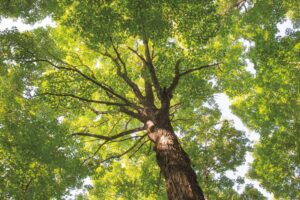Biologist and naturalist E. O. Wilson conceptualized biophilia as our innate attraction to nature and other living things in his 1984 book, Biophilia, a personal account of his experiences of nature as he conducted research in different parts of the world. As we think about ways to create healthier built environments more connected to nature, biophilia’s influence is increasing in architecture and design. An approach grounded in biological theory and supported by research in the social sciences and health, biophilia’s integration into design implies a deeper consideration of the natural environment and the relationship we have to it, whether our impact on natural resources or our evolutionary adapted responses to nature’s forms and patterns. From Stephen Kellert’s pioneering work on biophilic design to the intersections of architecture and neuroscience, biophilia bridges scientific and creative approaches to arrive at design solutions that promote physical, mental, and social health and wellbeing across a variety of settings, from healthcare to corporate and beyond.
The effects of exposure to nature on health and wellbeing are discussed in other design approaches, such as evidence-based design. In both evidence-based design and biophilia, the understanding of our relationship to nature is grounded in evolutionary theory that recognizes the significant interaction between our physiological and psychological development and the environment in which our ancestors evolved. In this framework, the interdependence of human life and the natural environment predisposes us to prefer environmental characteristics that are perceived to support our survival and to fear those that do not (biophobia). Some researchers and scholars investigating biophilia posit that our preferences for nature are not just about their fitness for survival, but that the aesthetics of nature have shaped our responses to particular types of environments, forms, and patterns. As Heerwagen and Hase point out, E.O. Wilson considers aesthetics a central issue of biophilia, and that he and others argue that “the pleasure we feel from being in beautiful places is part of the neural makeup of the human brain. Our sense of beauty evolved because it led our ancestors to seek out places that aided their survival and well being. Appreciating natural beauty isn’t something that some people have and others don’t. It doesn’t need advanced education and training. It happens without effort or even conscious awareness. The more our buildings can tap into our ancient sense of beauty, the more likely they will support us psychologically and emotionally, as well as functionally” (Heerwagen & Hase, 2001). In fact, many studies have demonstrated that not only do certain natural features have a positive impact on individuals (particularly in healthcare settings) but that people generally prefer depictions of nature to other subject matter in art.
As in evidence-based design, art plays a utilitarian role as a surrogate for ‘real’ nature in biophilic design. In frameworks such as those developed by Kellert and Calabrese ( The Practice of Biophilic Design, 2015) and Terrapin Bright Green (14 Patterns of Biophilic Design: Improving Health and Well-Being in the Built Environment, 2014) art serves as an indirect experience of nature or simulated visual connection with nature respectively. In both design frameworks, the emphasis on art depicting nature scenes is informed by health research that demonstrates that exposure to nature views can not only lower blood pressure but also lessen the length of hospital stays and the amount of pain medication taken by a patient. Exposure to views of nature, and to a lesser degree, surrogate images of nature have also been shown to relieve stress and to promote restoration when attention and other personal resources become fatigued. Taking into consideration the aesthetic dimension to nature mentioned above, as Grindal and Patil clearly state, “nature appears to have qualities useful for stress relief, mental restoration, and improved mood simply by being consciously or unconsciously “pleasing to the eye” (Grindal & Patil, 2009).
Selecting images of nature that are pleasing to the eye is only one facet of incorporating this indirect experience of nature. Supporting positive human-nature relationships and reinforcing the connection between a community and its natural environs in biophilic design entails a greater consideration of the local or regional environment. While familiar nature scenes of the area are a great starting point, taking the time to research indigenous plants and animals offers opportunities to create richer and more creative visual encounters with nature. Further, the manner in which a work of art speaks to other aspects of the indirect experience of nature, like through materials, color, and naturalistic shapes and forms can inform its selection. For example, the collection below takes the Great Lakes region as its starting point, incorporating landscapes as well as botanical and other images – as a view may not be an appropriate artwork choice for a particular biophilic setting. Images of nature such as these can be creatively integrated in such a way that they provide an indirect experience of nature while reinforcing other facets of biophilic design. Rather than simply producing framed prints, the incorporation of nature art demands consideration not only the way an image itself supports biophilia but also how its substrate and placement can encourage the “mutual reinforcing, interconnected, and integrated” solutions laid out by Kellert and Calabrese (2015). For example, a work of art may be better printed on wood for a particular interior, or reproducing a work of art on acrylic may be a better choice as a means to highlight or take advantage of the play of natural light in a space. In short, the possibilities for the incorporation of artwork into biophilic design are plentiful and create the opportunity for richly informed, diverse creative solutions that support the positive impact of the interior environment.



